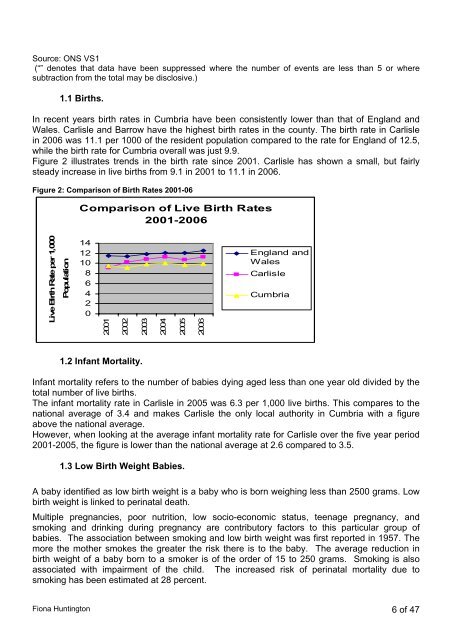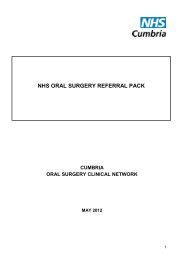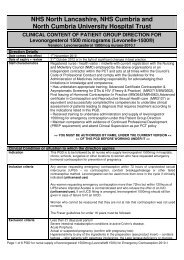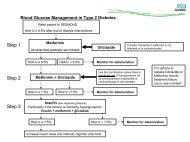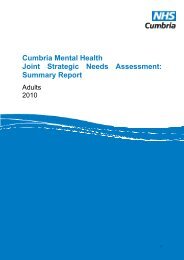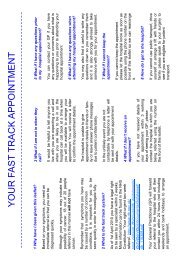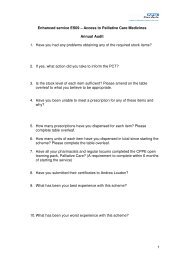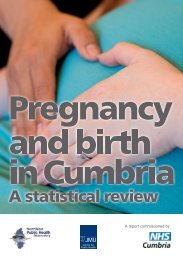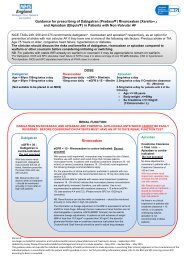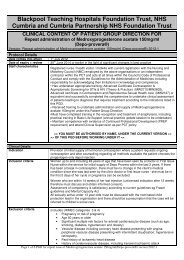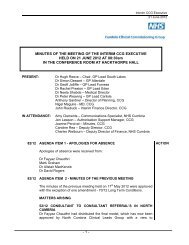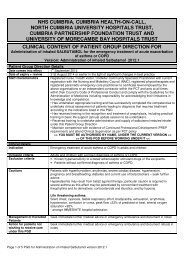Carlisle is the most northerly city in England, and the ... - NHS Cumbria
Carlisle is the most northerly city in England, and the ... - NHS Cumbria
Carlisle is the most northerly city in England, and the ... - NHS Cumbria
- No tags were found...
You also want an ePaper? Increase the reach of your titles
YUMPU automatically turns print PDFs into web optimized ePapers that Google loves.
Source: ONS VS1(“” denotes that data have been suppressed where <strong>the</strong> number of events are less than 5 or wheresubtraction from <strong>the</strong> total may be d<strong>is</strong>closive.)1.1 Births.In recent years birth rates <strong>in</strong> <strong>Cumbria</strong> have been cons<strong>is</strong>tently lower than that of <strong>Engl<strong>and</strong></strong> <strong>and</strong>Wales. <strong>Carl<strong>is</strong>le</strong> <strong>and</strong> Barrow have <strong>the</strong> highest birth rates <strong>in</strong> <strong>the</strong> county. The birth rate <strong>in</strong> <strong>Carl<strong>is</strong>le</strong><strong>in</strong> 2006 was 11.1 per 1000 of <strong>the</strong> resident population compared to <strong>the</strong> rate for <strong>Engl<strong>and</strong></strong> of 12.5,while <strong>the</strong> birth rate for <strong>Cumbria</strong> overall was just 9.9.Figure 2 illustrates trends <strong>in</strong> <strong>the</strong> birth rate s<strong>in</strong>ce 2001. <strong>Carl<strong>is</strong>le</strong> has shown a small, but fairlysteady <strong>in</strong>crease <strong>in</strong> live births from 9.1 <strong>in</strong> 2001 to 11.1 <strong>in</strong> 2006.Figure 2: Compar<strong>is</strong>on of Birth Rates 2001-06Compar<strong>is</strong>on of Live Birth Rates2001-2006Live Birth Rate per 1,000Population14121086420200120022003200420052006<strong>Engl<strong>and</strong></strong> <strong>and</strong>Wales<strong>Carl<strong>is</strong>le</strong><strong>Cumbria</strong>1.2 Infant Mortality.Infant mortality refers to <strong>the</strong> number of babies dy<strong>in</strong>g aged less than one year old divided by <strong>the</strong>total number of live births.The <strong>in</strong>fant mortality rate <strong>in</strong> <strong>Carl<strong>is</strong>le</strong> <strong>in</strong> 2005 was 6.3 per 1,000 live births. Th<strong>is</strong> compares to <strong>the</strong>national average of 3.4 <strong>and</strong> makes <strong>Carl<strong>is</strong>le</strong> <strong>the</strong> only local authority <strong>in</strong> <strong>Cumbria</strong> with a figureabove <strong>the</strong> national average.However, when look<strong>in</strong>g at <strong>the</strong> average <strong>in</strong>fant mortality rate for <strong>Carl<strong>is</strong>le</strong> over <strong>the</strong> five year period2001-2005, <strong>the</strong> figure <strong>is</strong> lower than <strong>the</strong> national average at 2.6 compared to 3.5.1.3 Low Birth Weight Babies.A baby identified as low birth weight <strong>is</strong> a baby who <strong>is</strong> born weigh<strong>in</strong>g less than 2500 grams. Lowbirth weight <strong>is</strong> l<strong>in</strong>ked to per<strong>in</strong>atal death.Multiple pregnancies, poor nutrition, low socio-economic status, teenage pregnancy, <strong>and</strong>smok<strong>in</strong>g <strong>and</strong> dr<strong>in</strong>k<strong>in</strong>g dur<strong>in</strong>g pregnancy are contributory factors to th<strong>is</strong> particular group ofbabies. The association between smok<strong>in</strong>g <strong>and</strong> low birth weight was first reported <strong>in</strong> 1957. Themore <strong>the</strong> mo<strong>the</strong>r smokes <strong>the</strong> greater <strong>the</strong> r<strong>is</strong>k <strong>the</strong>re <strong>is</strong> to <strong>the</strong> baby. The average reduction <strong>in</strong>birth weight of a baby born to a smoker <strong>is</strong> of <strong>the</strong> order of 15 to 250 grams. Smok<strong>in</strong>g <strong>is</strong> alsoassociated with impairment of <strong>the</strong> child. The <strong>in</strong>creased r<strong>is</strong>k of per<strong>in</strong>atal mortality due tosmok<strong>in</strong>g has been estimated at 28 percent.Fiona Hunt<strong>in</strong>gton 6 of 47


